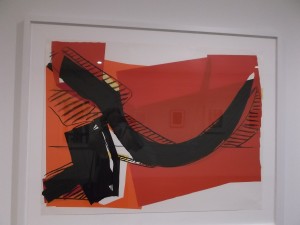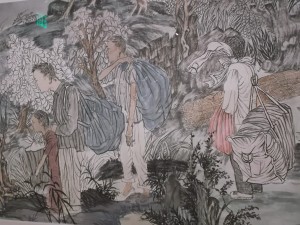Do you remember that a couple of months ago I wrote about visiting five art galleries on the UMass campus? I ran out of time that week and was not able to visit the sixth gallery on my list, but by now, we’ve begun another year and another semester. Although it was bitterly cold today even at mid-day, with a piercing wind, at the start of my lunch hour I headed across campus to the University Museum of Contemporary Art, a small gallery on the ground floor of the Fine Arts Center. This space was not always known as the UMCA; I remember previous visits when it was simply the Fine Arts Center Gallery. Perhaps the focus has sharpened and the mission has changed. At any rate, the website declares:
The University Museum of Contemporary Art – the teaching museum of the University Massachusetts Amherst – is a multidisciplinary, international laboratory for the exploration and advancement of contemporary art.
Through exhibitions, a permanent collection, educational programming, and a visiting artists program, the University Museum of Contemporary Art acts as a forum where renowned and emerging artists can test ideas and where diverse audiences can participate in cultural experiences that enhance understanding of the art of our time.
This year the gallery is celebrating its fortieth year with a special exhibit titled 40 Years/40 Artists. In recognition of the UMCA’s impact on their careers, local, national, and international artists agreed to donate works to the UMCA’s permanent collection; this diverse group includes such figures as Daniel Buren, LaToya Ruby Frazier, Jenny Holzer, Robert Irwin, Ellen Phelan, Avery Preesman, Scott Prior, Joel Shapiro, Beat Streuli, Andy Warhol, Carrie Mae Weems, and William Wegman. Insofar as the Museum collects primarily works on paper, most of these donated works are photographs, drawings, or prints.
As I mentioned before, I have conventional tastes, so I must confess that my favorite works from this exhibit were the six silkscreen prints by Andy Warhol; I especially liked Sitting Bull, 1986, and Hammer and Sickle, 1977.
I brought my camera with me, and when I saw some other students taking photos with those ubiquitous smart phones, I snapped a few shots, without using flash, of course. I’m not sure of the legality of all this, but these materials are copyrighted; please don’t re-publish them without attribution.
I also admired William Wegman‘s silver gelatin print Double Header, 1992, and Scott Prior‘s Pumpkins and Snowman, both polymer intaglio and digital pigment ink prints from 2005.
Also on exhibit at the UMCA until March 8th is Yu-Fei Ji‘s Migrants, Ghosts, and the Dam. This contemporary Chinese artist is known for his use of traditional ink painting on handmade rice paper: he uses centuries-old painting techniques, including calligraphy, in the style of traditional Chinese landscape painting. On display are a number of his works from the past ten years, including a scroll painting, which when unrolled is over ten meters long, as well as a three-meter-long watercolor woodcut print. The contrast between his style and his subjects, such as the Three Gorges Dam and its negative consequences for millions of village people, is striking. The artist has been in residency as UMass this past week and participated in a number of public talks and workshops. Last night the film Still Life, directed by Jia Zhangke, was screened at the School of Management Auditorium, with the artist on hand for commentary.
This photo is a close-up of one section of Four People Leaving Badong, 2009, ink and watercolor on Xuan paper:


